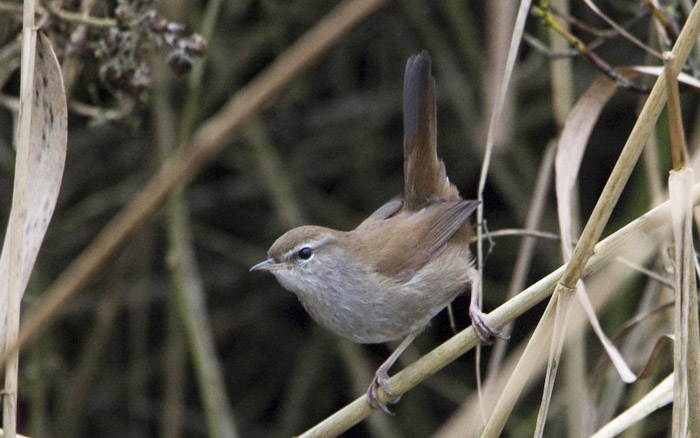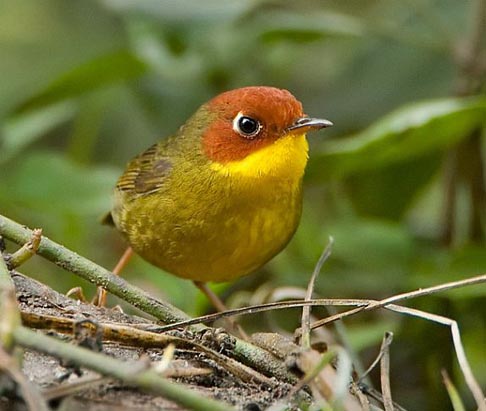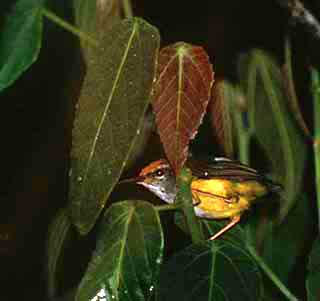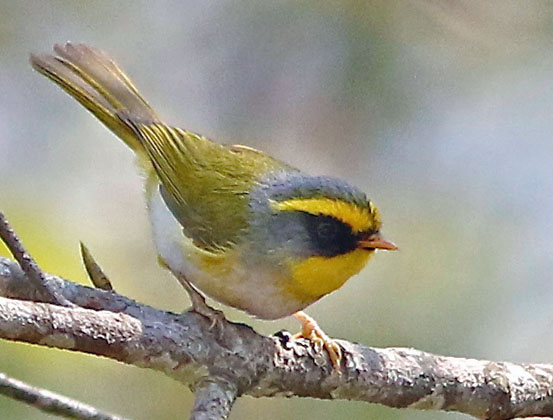| |
CETTIDS Cettiidae
Bush Warblers, Stubtails, Tesias and allies |
- 33 species in the Old World
- DR personal total: 17 species (51%), 6 photo'd
|
 The "Old World Warblers," when assigned to the traditional family Sylviidae, once included ~400 species, the second largest family on earth. At the turn of the 21st century, new molecular information revealed that this huge "Old World Warbler family" actually represented a dozen or more different major evolutionary lineages; Alström et al. (2006), Jønsson & Fjeldså (2006), Barker et al. (2004); for an overview see an old page on the Break-Up of the Old World Warblers. Alström et al. (2006) began the inevitable process of splitting them into new families, proposing Family names for several of the lineages and leaving others for later studies. They proposed the Family name Cettiidae for a group of diverse "warblers" from Eurasia, and even a couple "tailorbirds" from the Orient. Together, these may be called the Cettid Warblers, or, more simply, Cettids [pronounced "Chet-ids"]. The "Old World Warblers," when assigned to the traditional family Sylviidae, once included ~400 species, the second largest family on earth. At the turn of the 21st century, new molecular information revealed that this huge "Old World Warbler family" actually represented a dozen or more different major evolutionary lineages; Alström et al. (2006), Jønsson & Fjeldså (2006), Barker et al. (2004); for an overview see an old page on the Break-Up of the Old World Warblers. Alström et al. (2006) began the inevitable process of splitting them into new families, proposing Family names for several of the lineages and leaving others for later studies. They proposed the Family name Cettiidae for a group of diverse "warblers" from Eurasia, and even a couple "tailorbirds" from the Orient. Together, these may be called the Cettid Warblers, or, more simply, Cettids [pronounced "Chet-ids"].
The core Cettids are 14 species of Bush Warblers in three genera [two of 4 species in genus Cettia, 11 of 13 species in Horornis, and one of 5 species in Urosphena]. These are all notorious skulkers, often heard but seldom seen. These tend to be plain brown birds with whitish or dull underparts; some are accomplished songsters. An example is Philippine Bush Warbler (left), endemic to the mountains of northern Luzon, Philippines. In this lucky shot, we saw this shy bird spreading its wings and sun-bathing in a sunbeam that penetrated the otherwise thick undergrowth. |
The formal Latin name has been the subject of confusion. As I understand it, "Cettidae" was proposed at least twice in the 19th century, and should have priority, but Alström et al. (2006) proposed the name again. Some objected to the lack of certain formalities in the 2006 proposal, leaving Scotocercidae as the "fall-back" position (e.g., see Winkler et al. 2015). More recently, some have resurrected the 19th century name. I'm not expert in these topics. For simplicity, I'll use Cettiidae again until the formal family name is better resolved. As to English parlance, this family is often called "Bush Warblers & allies," and there are 14 species whose English name is "Bush Warbler." However, there are about 15 more "Bush Warblers" in family Locustellidae, most of them in genus Locustella. So it is probably better to call our group Cettids. |
 The initially proposed family name Cettiidae was derived from the first described bird in this set, Cetti's Warbler (right, in a marvelous shot by Graham Catley). This is a breeding bird of reedy swamps from western Europe (including Britain) and northwest Africa across to northwest India. Western populations are resident, but many eastern populations are migratory. It is a skulker, more often seen than heard. The bird's behavior in Graham's photo reminds me of the characters (cocked tail, aggressive stance, large feet, retiring nature) that typify Marsh Wrens here in America. As the molecular evidence accumulates about this family and we learn of the true relationships, the genus Cettia has been restricted to four species, and could be revised again. The initially proposed family name Cettiidae was derived from the first described bird in this set, Cetti's Warbler (right, in a marvelous shot by Graham Catley). This is a breeding bird of reedy swamps from western Europe (including Britain) and northwest Africa across to northwest India. Western populations are resident, but many eastern populations are migratory. It is a skulker, more often seen than heard. The bird's behavior in Graham's photo reminds me of the characters (cocked tail, aggressive stance, large feet, retiring nature) that typify Marsh Wrens here in America. As the molecular evidence accumulates about this family and we learn of the true relationships, the genus Cettia has been restricted to four species, and could be revised again.
|
 There are various ground-hugging forest species in the Cettiidae, like the nearly tail-less stubtails (3 of 5 species in genus Urosphena) and tesias (5 species of tesias, 4 of them in genus Tesia). Stubtails, like Bush Warblers and Cetti's Warbler, are generally plain, brown, and unremarkable in appearance, but Tesias are different. They can be remarkably colorful, as exemplified by Chestnut-headed Tesia (left, in a magical shot by Ramki Sreenivasan from India). This is a tiny little bird creeping around the jungle floor, and a great treat to encounter. There are various ground-hugging forest species in the Cettiidae, like the nearly tail-less stubtails (3 of 5 species in genus Urosphena) and tesias (5 species of tesias, 4 of them in genus Tesia). Stubtails, like Bush Warblers and Cetti's Warbler, are generally plain, brown, and unremarkable in appearance, but Tesias are different. They can be remarkably colorful, as exemplified by Chestnut-headed Tesia (left, in a magical shot by Ramki Sreenivasan from India). This is a tiny little bird creeping around the jungle floor, and a great treat to encounter.
The Cettiidae was initially a Eurasian family but there is a forest floor skulker in the heart of Africa: Neumann's Warbler of the Albertine Rift. It was known as Hemitesia neumanni but has recently been moved by some to Urosphena. That is the genus of the Oriental stubtails, although it is still somewhat distant; Irestedt et al. (2011). Those authors called it "the sole African member of a Palaeotropic Miocene avifauna," leaving Neumann's Warbler as a relict.
|
 Earlier suggestions that this family might include such African species Green Hylia Hylia prasina, or the Eremomelas, were off-target. Hylia is apparently a long-evolved lineage and may warrant Family status [tentatively so here], while the Eremomelas are cisticolids. There are still some other African birds that are closely related to cettids, and sometimes included among them (see below). Earlier suggestions that this family might include such African species Green Hylia Hylia prasina, or the Eremomelas, were off-target. Hylia is apparently a long-evolved lineage and may warrant Family status [tentatively so here], while the Eremomelas are cisticolids. There are still some other African birds that are closely related to cettids, and sometimes included among them (see below).
Another surprise revealed by genetic research was that the tailorbirds were not a unified group. Some tailorbirds proved to be closely related to cisticolas and prinias [family Cisticolidae] but the two Phyllergates tailorbirds in the Orient proved to be cettids. One of these is Mountain Tailorbird (right), which ranges from southern Asia to the Philippines and Wallacea. These tailorbirds had previously been assigned to genus Orthotomus (see Alström et al. 2006). Thus not only are tesias an example of colorful cettids, but so are these two tailorbirds (the other Phyllergates is Rufous-headed Tailorbird P. heterolaemus of the Philippines). While there are many places where these tailorbirds are undergrowth skulkers, they can be found in canopy of some montane forests. |
 The full parameters of the rest of the Cettiidae are starting to come into focus (Fregin et al. 2012). In addition to those discussed above, it includes Broad-billed Warbler Tickella hodgsoni, and three warblers in the Asian genus Abroscopus [Yellow-bellied Warbler A. superciliaris, Black-faced Warbler A. schisticeps, and Rufous-faced Warbler A. albogularis]. The Broad-billed Warbler superficially looks like Mountain Tailorbird and is an i.d. problem in the Himalayas. The Abroscopus warblers can be very colorful. Black-faced Warbler (left) is a beautiful little warbler that joins mixed species flocks in the subtropical forests of the Himalayas. The full parameters of the rest of the Cettiidae are starting to come into focus (Fregin et al. 2012). In addition to those discussed above, it includes Broad-billed Warbler Tickella hodgsoni, and three warblers in the Asian genus Abroscopus [Yellow-bellied Warbler A. superciliaris, Black-faced Warbler A. schisticeps, and Rufous-faced Warbler A. albogularis]. The Broad-billed Warbler superficially looks like Mountain Tailorbird and is an i.d. problem in the Himalayas. The Abroscopus warblers can be very colorful. Black-faced Warbler (left) is a beautiful little warbler that joins mixed species flocks in the subtropical forests of the Himalayas.
Under some taxonomies (including mine), the family also includes Scrub Warbler Scotocerca inquieta of north African and the Middle East (Alström et al. 2011a). |
 Fregin et al. (2012) proposed treating the genus Scotocerca as a separate family "Scotocercidae." [Ironically it later became the name for the full Cettid family, at least for a few years, because "Cettiidae" was alleged to not have been properly proposed under formal rules. There is still confusion on this, see above.] Fregin et al's (2012) proposal was based primarily on a "long internode" in the phylogeny of the family. The authors published evidence that Scrub Warbler (right, artwork of two races by John Gale) was sister to the rest of the "Cettiidae" but there are hundreds of instances in the avian tree of life where a single taxa is sister to a related clade of species. In my view, this is hardly a reason to raise Scrub Warbler to a monotypical family level. It is a dull, skulking, wren-like "warbler" of desert scrub, not particularly distinct from other retiring cettids. Yes, it proved not to be related to the Cisticolidae but has evolved a convergent lifestyle. I leave it among the Cettiidae [it could possibly be a subfamily]. Fregin et al. (2012) proposed treating the genus Scotocerca as a separate family "Scotocercidae." [Ironically it later became the name for the full Cettid family, at least for a few years, because "Cettiidae" was alleged to not have been properly proposed under formal rules. There is still confusion on this, see above.] Fregin et al's (2012) proposal was based primarily on a "long internode" in the phylogeny of the family. The authors published evidence that Scrub Warbler (right, artwork of two races by John Gale) was sister to the rest of the "Cettiidae" but there are hundreds of instances in the avian tree of life where a single taxa is sister to a related clade of species. In my view, this is hardly a reason to raise Scrub Warbler to a monotypical family level. It is a dull, skulking, wren-like "warbler" of desert scrub, not particularly distinct from other retiring cettids. Yes, it proved not to be related to the Cisticolidae but has evolved a convergent lifestyle. I leave it among the Cettiidae [it could possibly be a subfamily].
Fregin et al. (2012) also proposed treating the genus Erythrocercus — three "flycatchers" from sub Saharan Africa — as a separate family, Erythrocercidae. These birds are sister to the clade of Cettiidae plus Scrub Warbler. One reason for separating them is that they have 12 rectrices rather than the 10 which the other Cettiidae (including Scrub Warbler) have. They are African rather than Asian; they are apparently rather ancient; and they are distinctive and diagnosable. I have tentatively accepted this proposal and have named this set Bristle-flycatchers [see that web page for more details]. If this proposal does not gain wide acceptance, the bristle-flycatchers in genus Erythrocercus will likely become a subfamily of the Scotocercidae. |
| |
Photos: The Philippine Bush Warbler Horornis seebohmi was in the undergrowth high on Mt. Pollis, Luzon, the Philippines, on 31 Dec 2005. Graham Catley photographed the Cetti's Warbler Cettia cetti in Lincolnshire, Britain, on 27 Jan 2011. Ramki Sreenivasan photographed the Chestnut-headed Tesia Cettia (or Oligura?) castaneocoronata in Corbett NP, India, in Feb 2010. The Mountain Tailorbird Phyllergates cuculatus was foraging just off my balcony at the hostel in Mt. Kinabalu Park, Borneo, Malaysia, in Aug 1988. The Black-faced Warbler Abroscopus schisticeps was at Morong, Bhutan, on 19 Mar 2019.
Photos © Don Roberson except those attributed to © Graham Catley and © Ramki Sreenivasan, and used with permission; all rights reserved. The artwork of Scrub Warbler Scotocerca inquieta by John Gale is from Birds of the Middle East, 2d ed., by R. Porter & S. Aspinall (Princeton Univ. Press).
Bibliographic note: There is no "family book" covering the cettids so information must be sought in a variety of texts, including the HBW species accounts of sylvioid warblers in Bairlein (2006).
Literature cited:
Alström, P., P.G.P. Ericson, U. Olsson, and P. Sundberg. 2006. Phylogeny and classification of the avian superfamily Sylvioidea. Molec. Phylog. Evol. 38: 381–397.
Alström, P., J. Fjeldså, S. Fregin, and U. Olsson. 2011a. Gross morphology betrays phylogeny: the Scrub Warbler Scotocerca inquieta is not a cisticolid. Ibis 153: 87–97.
Alström, P., S. Fregin, J.A. Norman, P.G.P. Ericson, L. Christidis, and U. Olsson. 2011b. Multilocus analysis of a taxonomically densely sampled dataset reveal extensive non-monophyly in the avian family Locustellidae. Molec. Phylog. Evol. 38: 381–397.
Bairlein, F. 2006. "Family Sylviidae (Old World Warblers)," pp. 492–712 in Handbook of the Birds of the World (del Hoyo, J., A. Elliott & D.A. Christie, eds). Vol. 11. Lynx Edicions, Barcelona, Spain.
Barker, F.K., A. Cibois, P. Schikler, J. Feinstein, and J. Cracraft. 2004. Phylogeny and diversification of the largest avian radiation. Proc. Nat. Acad. Sci. 101: 11040–11045.
Fregin, S., M. Haase, P. Alström, and U. Olsson. 2012. New insights into family relationships within the avian superfamily Sylvioidea (Passeriformes) based on seven molecular markers. BMC Evol. Biol. 12: 157–179.
Irestedt, M., M. Gelang, G. Sangster, U. Olsson, P.G.P. Ericson, and P. Alström. 2011. Neumann's Warbler Hemitesia neumanni (Sylvioidea): the sole African member of a Palaeotropic Miocene avifauna. Ibis 153: 78–86.
Jønsson, K.A., and J. Fjeldså. 2006. A phylogenetic supertree of oscine passerine birds. Zoologica Scripta 35: 149–186.
Winkler, D.W., S.W. Billerman, and I.J. Lovette. 2015. Birds Families of the World: A Guide to the Spectacular Diversity of Birds. Lynx Edicions, Barcelona.
|
|
|

 The "Old World Warblers," when assigned to the traditional family Sylviidae, once included ~400 species, the second largest family on earth. At the turn of the 21st century, new molecular information revealed that this huge "Old World Warbler family" actually represented a dozen or more different major evolutionary lineages; Alström et al. (2006), Jønsson & Fjeldså (2006), Barker et al. (2004); for an overview see an old page on the
The "Old World Warblers," when assigned to the traditional family Sylviidae, once included ~400 species, the second largest family on earth. At the turn of the 21st century, new molecular information revealed that this huge "Old World Warbler family" actually represented a dozen or more different major evolutionary lineages; Alström et al. (2006), Jønsson & Fjeldså (2006), Barker et al. (2004); for an overview see an old page on the  The initially proposed family name Cettiidae was derived from the first described bird in this set, Cetti's Warbler (right, in a marvelous shot by Graham Catley). This is a breeding bird of reedy swamps from western Europe (including Britain) and northwest Africa across to northwest India. Western populations are resident, but many eastern populations are migratory. It is a skulker, more often seen than heard. The bird's behavior in Graham's photo reminds me of the characters (cocked tail, aggressive stance, large feet, retiring nature) that typify Marsh Wrens here in America. As the molecular evidence accumulates about this family and we learn of the true relationships, the genus Cettia has been restricted to four species, and could be revised again.
The initially proposed family name Cettiidae was derived from the first described bird in this set, Cetti's Warbler (right, in a marvelous shot by Graham Catley). This is a breeding bird of reedy swamps from western Europe (including Britain) and northwest Africa across to northwest India. Western populations are resident, but many eastern populations are migratory. It is a skulker, more often seen than heard. The bird's behavior in Graham's photo reminds me of the characters (cocked tail, aggressive stance, large feet, retiring nature) that typify Marsh Wrens here in America. As the molecular evidence accumulates about this family and we learn of the true relationships, the genus Cettia has been restricted to four species, and could be revised again.  There are various ground-hugging forest species in the Cettiidae, like the nearly tail-less stubtails (3 of 5 species in genus Urosphena) and tesias (5 species of tesias, 4 of them in genus Tesia). Stubtails, like Bush Warblers and Cetti's Warbler, are generally plain, brown, and unremarkable in appearance, but Tesias are different. They can be remarkably colorful, as exemplified by Chestnut-headed Tesia (left, in a magical shot by Ramki Sreenivasan from India). This is a tiny little bird creeping around the jungle floor, and a great treat to encounter.
There are various ground-hugging forest species in the Cettiidae, like the nearly tail-less stubtails (3 of 5 species in genus Urosphena) and tesias (5 species of tesias, 4 of them in genus Tesia). Stubtails, like Bush Warblers and Cetti's Warbler, are generally plain, brown, and unremarkable in appearance, but Tesias are different. They can be remarkably colorful, as exemplified by Chestnut-headed Tesia (left, in a magical shot by Ramki Sreenivasan from India). This is a tiny little bird creeping around the jungle floor, and a great treat to encounter. Earlier suggestions that this family might include such African species Green Hylia Hylia prasina, or the Eremomelas, were off-target. Hylia is apparently a long-evolved lineage and may warrant Family status [
Earlier suggestions that this family might include such African species Green Hylia Hylia prasina, or the Eremomelas, were off-target. Hylia is apparently a long-evolved lineage and may warrant Family status [ The full parameters of the rest of the Cettiidae are starting to come into focus (Fregin et al. 2012). In addition to those discussed above, it includes Broad-billed Warbler Tickella hodgsoni, and three warblers in the Asian genus Abroscopus [Yellow-bellied Warbler A. superciliaris, Black-faced Warbler A. schisticeps, and Rufous-faced Warbler A. albogularis]. The Broad-billed Warbler superficially looks like Mountain Tailorbird and is an i.d. problem in the Himalayas. The Abroscopus warblers can be very colorful. Black-faced Warbler (left) is a beautiful little warbler that joins mixed species flocks in the subtropical forests of the Himalayas.
The full parameters of the rest of the Cettiidae are starting to come into focus (Fregin et al. 2012). In addition to those discussed above, it includes Broad-billed Warbler Tickella hodgsoni, and three warblers in the Asian genus Abroscopus [Yellow-bellied Warbler A. superciliaris, Black-faced Warbler A. schisticeps, and Rufous-faced Warbler A. albogularis]. The Broad-billed Warbler superficially looks like Mountain Tailorbird and is an i.d. problem in the Himalayas. The Abroscopus warblers can be very colorful. Black-faced Warbler (left) is a beautiful little warbler that joins mixed species flocks in the subtropical forests of the Himalayas.  Fregin et al. (2012) proposed treating the genus Scotocerca as a separate family "Scotocercidae." [Ironically it later became the name for the full Cettid family, at least for a few years, because "Cettiidae" was alleged to not have been properly proposed under formal rules. There is still confusion on this, see above.] Fregin et al's (2012) proposal was based primarily on a "long internode" in the phylogeny of the family. The authors published evidence that Scrub Warbler (right, artwork of two races by John Gale) was sister to the rest of the "Cettiidae" but there are hundreds of instances in the avian tree of life where a single taxa is sister to a related clade of species. In my view, this is hardly a reason to raise Scrub Warbler to a monotypical family level. It is a dull, skulking, wren-like "warbler" of desert scrub, not particularly distinct from other retiring cettids. Yes, it proved not to be related to the Cisticolidae but has evolved a convergent lifestyle. I leave it among the Cettiidae [it could possibly be a subfamily].
Fregin et al. (2012) proposed treating the genus Scotocerca as a separate family "Scotocercidae." [Ironically it later became the name for the full Cettid family, at least for a few years, because "Cettiidae" was alleged to not have been properly proposed under formal rules. There is still confusion on this, see above.] Fregin et al's (2012) proposal was based primarily on a "long internode" in the phylogeny of the family. The authors published evidence that Scrub Warbler (right, artwork of two races by John Gale) was sister to the rest of the "Cettiidae" but there are hundreds of instances in the avian tree of life where a single taxa is sister to a related clade of species. In my view, this is hardly a reason to raise Scrub Warbler to a monotypical family level. It is a dull, skulking, wren-like "warbler" of desert scrub, not particularly distinct from other retiring cettids. Yes, it proved not to be related to the Cisticolidae but has evolved a convergent lifestyle. I leave it among the Cettiidae [it could possibly be a subfamily].